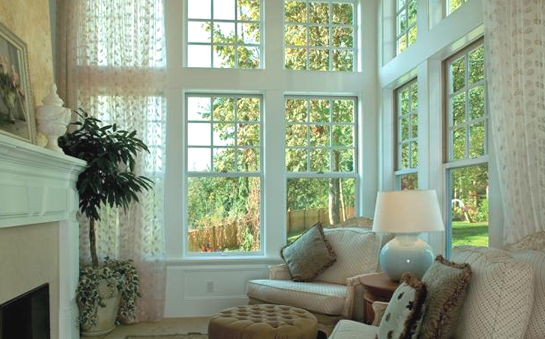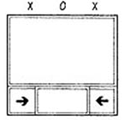Our Products
RenovatingLA Replacement Window Guide
Window Materials
Aluminum: Generally the least expensive material used in the manufacture of window frames. Lightweight, yet strong, aluminum was a very common window material from the late 50's until recently. However, it is the least energy efficient of all the window materials because aluminum is a very good thermal conductor so you loose energy through the aluminum frame even if you have insulated glass.
Vinyl: With the higher costs of energy for heating and cooling in the seventies and eighties window manufacturers looked for an alternative to aluminum for window frame material. Vinyl costs 5-25% more than aluminum windows, but you get up to 30% better energy efficiency in the overall window if you compare dual glazed aluminum windows to dual glazed vinyl windows. And like aluminum windows, you have very little maintenance.
Wood: The original window frame material. Wood windows are beautiful to look at and are generally very energy efficient when using dual glass. The disadvantages of wood though are the higher costs (generally about 2-3 times what vinyl windows cost) and more maintenance. You can get wood windows with more maintenance free exteriors. They can be clad with aluminum, vinyl, or fiberglass. This way you can have the nice look of wood, but with a more durable exterior.
Types of Frames (Installation)
New Construction: Also called a nail-on frame and usually used for new construction, but can also be installed as replacement windows. The window frame is nailed to the studs around the window opening. Flashing paper is then placed around the window to help keep the installation watertight. Then, finishing is applied around the opening and window.
Retrofit: This type of window installation is used where you have existing wood or aluminum windows and don't want to tear out stucco or siding but want to upgrade your windows to better operating, energy efficient windows.
Glass Types
Single Glass: This means the windows has one pane of glass in each panel. It has very little insulating value. Most building departments don't allow single glass anymore because it is so energy inefficient.
Double Glass: Also called insulated glass or dual glazed windows. This is made up of 2 pieces of glass with an airspace in between. This airspace cuts the heat transferred from one side of the glass to the other nearly in half.
Argon: This is not actually a type of glass but is a gas that is put into the space between the panes of glass in a dual glazed window. This adds to the insulating value of the window (about 3-5%) and is not very expensive.
Low E: This is a metallic coating put onto the inner surface of the outer pane of glass in a dual glazed window. It works by reflecting most of the ultraviolet rays (the component of light that does the most damage to your carpets and drapes) and infrared rays (radiant heat). This actually increases the insulating value of the glass 15-30%. It also reduces solar heat gain. Most window manufacturers now are using Low E-2 or Low E squared which is an improved multicoated version.
Tinted Glass: Window glass can be ordered in a variety of different tints. Tinted glass is mainly used to reduce sun glare. It does reduce the solar heat gain, but does not add to the insulating properties of the glass like Low E does. The different tints that are readily available are solar bronze or gray, bronze reflective, azurlite (blue), evergreen, #31 graylite (dark), and #14 graylite (very dark).
Tempered Glass: Tempered glass is also called safety glass. It is used in all doors, any window that is within 18" of the floor, or any window in a tub or shower area.
Obscure Glass: As the name implies this type of glass is used were you don't want people to easily see through a window. P516 is the kind obscure of glass you see in most bathroom windows. However, you can also get rainglass, glue chip, reed glass, and many others.
Window Coverings
There are many different types of window coverings, shades and blinds available on the market today. Unfortunately we do not sell them. We can provide you with any type of window but for the coverings you will have to look else where.
Window Types
Horizontal Slider: This window has one or two panels that slide left or right. A popular style for contemporary homes. Horizontal sliders are typically used for bedrooms requiring egress.
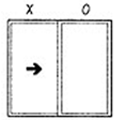 Half-Vent |
 Single Vent |
 Double Vent |
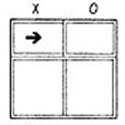 Half-Vent Above 2-Lites Below |
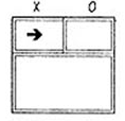 Half-Vent Above |
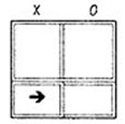 Half-Vent Below 2-Lites Above |
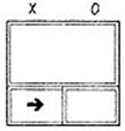 Half-Vent Below |
|
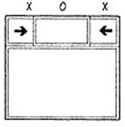 Double-Vent Above |
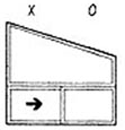 Half-Vent Below Gable Above |
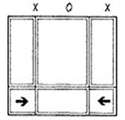 Double-Vent Below 3 Lites Above |
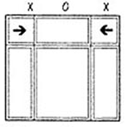 Double-Vent Above 3 Lites Below |
Single Hung: This is a vertical slider, where the bottom panel slides up and down. This is done with some sort of balance mechanism to support the weight of the panel.
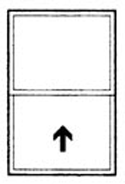 Single Hung |
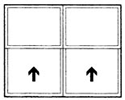 Double-Single Hung |
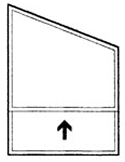 Gable Top Single Hung |
 Double-Single Hung Center Picture |
 Triple-Single Hung |
Double Hung: This is a vertical sliding window in which both the upper and lower panel can slide up and down. Because there is more mechanism this is more expensive than the single hung window.
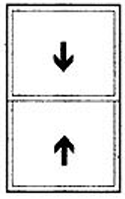 Double Hung |
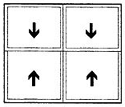 Double-Double Hung |
 Triple-Double Hung |
 Double-double Hung Center Picture |
Picture Window: This is commonly called a fixed window. There is no operating panel.
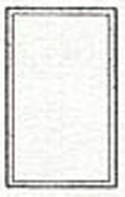 Picture Window |
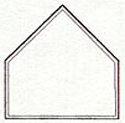 Picture Window Gable |
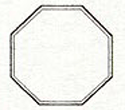 Picture Window Octagon |
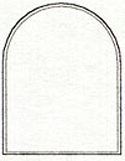 Picture Window Round Top |
 Picture Window Half-Round |
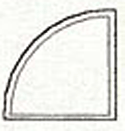 Picture Window Quarter-Round |
 Picture Window Arch-Top |
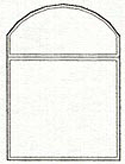 Picture Window Full With Arch-Top |
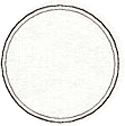 Picture Window Full Round |
Casement Window: This type of window is hinged on one side and cranks out. This gives you a lot of ventilation, but you need to be careful of clearance on the outside. You wouldn't want a casement sticking out where people might bump into it. Usually more expensive than a sliding window.
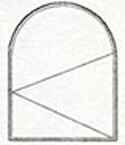 Archtop Casement |
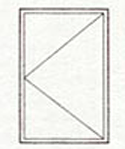 Full Casement |
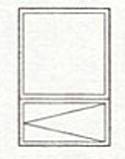 Bottom Casement |
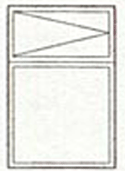 Top Casement |
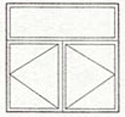 Double Bottom Casement |
 Double Casement Center Picture |
 Single Casement |
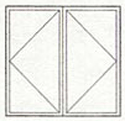 Double Casement |
Awning: This type of window is similar to the casement window, but it is hinged at the top and swings out a few inches from the bottom
 Full Awning |
 Single Awning |
 Double Awning |
|
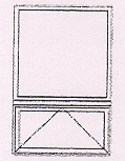 Bottom Awning |
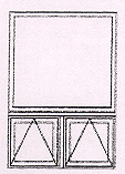 Double Bottom Awning |
 Full Awning Stacked2-Vertical |
 Double Awning Stacked 2-Vertical |
 Double Bottom Awning 2-Lites Vertical |
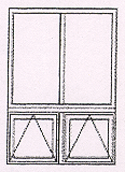 Bottom Awning 2-Lites |
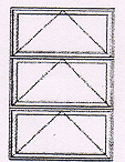 Full Awning Stacked 3-Vertical |
 Double Awning Stacked 3-Vertical |
Bay & Bow Windows: Bay and bow windows are made up of combinations of windows, usually picture windows, and casements or single hung windows. Bays are made up of 3 panels, with a picture window center and either a casement or single hung window on either side at a 45 degree angle. Bow window are combinations of picture windows, and casement or single hung windows joined at about a 13 degree angle. There can be three, four, or even five panels in a bow window.
 Bay Picture Window |
 Bay Half-Vent Slider |
 Bay 2 Single Hung |
 Bay 2 Casement |
 Bow Casement 3-Segment |
 Bow Picture 4-Segment |
 Bow 2 Single Hung 3-Segment |
Garden Windows: These windows are designed as the perfect place to pamper your favorite plants with lots of light. A variety of designs are available to fit perfectly in any window opening.
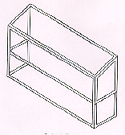 |
Four Steps to Creating a Totally New Look
Your existing windows are cracking and peeling. You can't get bedroom windows all the way open for fresh air on long summer nights. In cold weather months, a draft coming through your front window chills you to the bone. You know you need replacement windows, but you wonder what to expect in the installation process. Once you select BH Kruper to do the job, replacing your existing windows and patio doors is an easy and hassle-free four-step process.
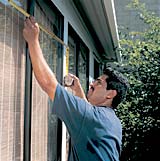 Measure Opening Before any window or door is removed, BH Kruper measures each opening to ensure every unit is built to your required size. |
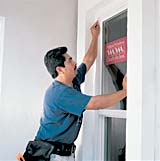 Remove Old Unit and Install New Unit BH Kruper is experienced in knowing which method of installation is best for each type of home siding. |
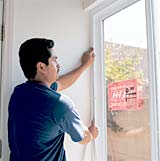 Insulate and Trim Interior Perimeter insulation is added to seal drafts. Interior and exterior trim is hung to create a finished look. |
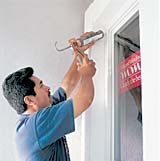 Seal and Finish Exterior BH Kruper then seals the exterior to make it watertight and does final touchup. That's it. |



